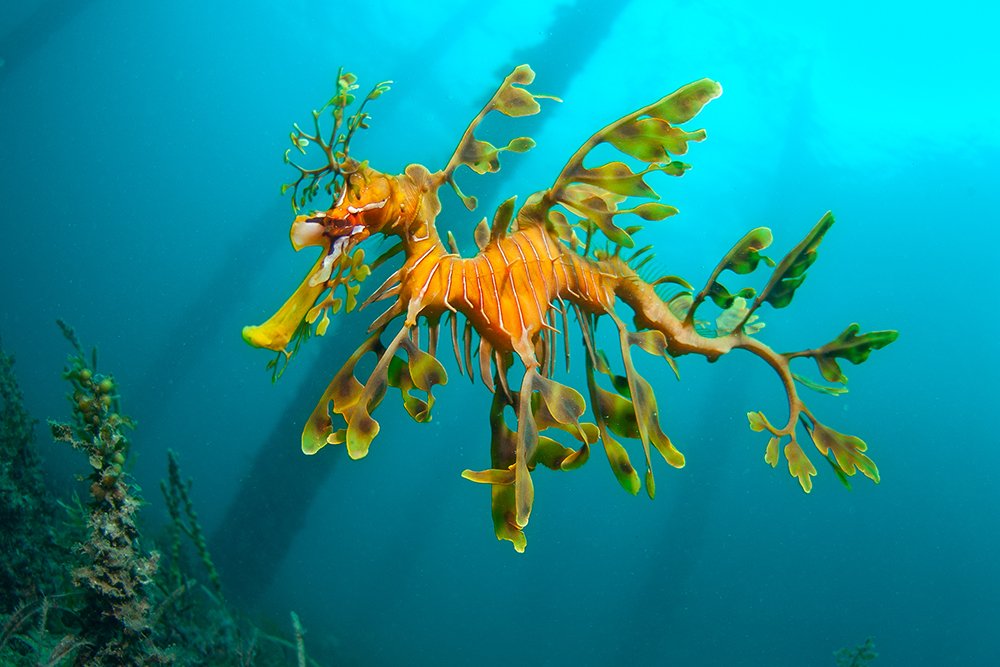Hello friends
Good morning everyone, in this simple blog we will review interesting topics related to The Fascinating World of Sea Dragons: Marine Fish with Leafy Appendages. Let’s take a good look at the following information so that our insight increases and opens our minds further.
The Fascinating World of Sea Dragons: Marine Fish with Leafy Appendages

Located in the coastal waters of Australia, New Zealand, and parts of Southeast Asia, sea dragons are marine fish known for their unique appearance and intriguing behavior. These fascinating creatures belong to the Syngnathidae family, which also includes seahorses and pipefish. With their leafy appendages and striking color patterns, sea dragons have captivated the imagination of divers and marine enthusiasts alike. In this article, we will delve into the world of sea dragons, exploring their biology, habitat, behavior, and conservation status.
Physical Characteristics and Appearance
Sea dragons are relatively small, ranging in size from 10 to 30 cm (4 to 12 inches) in length. Adult sea dragons have a slightly elongated body, covered in bony plates that provide protection from predators. The most distinctive feature of sea dragons is their elaborate appendages, which are used for camouflage and breathing. These branching or leafy appendages can be up to 15 cm (6 inches) in length and are characterized by their striking resemblance to seaweed. The number and shape of these appendages can vary depending on the species, with some having up to 200 leaf-like projections.
One of the most impressive aspects of sea dragons is their coloration. Adult sea dragons display vibrant green, yellow, brown, or red hues, often with intricate patterns and swirling shapes. The bright colors serve as a warning to potential predators that the sea dragons are distasteful or toxic. In some species, the color pattern changes depending on the sex of the individual, providing further insight into their biology.
Biology and Life Cycle
Sea dragons are ovoviviparous, which means they produce eggs that hatch and develop inside the mother’s body. The female sea dragon stores the eggs in a brood pouch on her belly, where they are nourished and protected until they are ready to hatch. The gestation period for sea dragons can range from a few weeks to several months, depending on the species and environmental conditions.
Newly hatched sea dragons, called larvae, are tiny and tadpole-like, with a yellowish color and a short tail. As they develop, they begin to grow the characteristic leafy appendages and their fins, developing their stunning color patterns. The larvae feed on small invertebrates and plankton, while the adults consume a diet of copepods, shrimp, and crustaceans.
Habitat and Distribution
Sea dragons are found in shallow waters, often near coastal rocks and reefs. In Australia, where the greatest diversity of species is found, sea dragons inhabit areas with a mix of rocky structures, sand, and seaweed. New Zealand’s coasts, particularly those around the South Island, are also home to small populations of sea dragons.
In Southeast Asia, where the sea dragon was first discovered, the species occurs in shallow, tropical waters. However, their distribution and numbers have decreased significantly due to habitat destruction and overfishing. As the marine environment continues to change due to climate change and human activities, it’s essential to monitor and protect the sea dragon habitats to prevent further decline.

Behavior and Social Structure
Sea dragons are generally solitary animals and spend most of their time swimming along the seafloor, usually at dusk or in the early morning hours. Their speed is relatively slow, with some species reaching speeds of up to 0.03 km/h (0.02 mph). The slow swimming speed is likely due to their energy-efficient feeding habits and ability to detect prey using their highly developed sense of smell.
In terms of social structure, sea dragons do not form large aggregations, and they do not have a complex hierarchical system. While males have been observed competing for spawning space near the surface of the water, there is little to no evidence of aggression or dominance in non-breeding individuals.
Conservation Status
The primary threats to sea dragon populations include:
- Habitat destruction due to human activities like mining, construction, and recreational boating.
- Overfishing for sea dragons for the aquarium trade and as a food source.
- Climate change, which affects the availability of food resources and disrupts the marine ecosystem.
- Entanglement in fishing gear and marine debris.
Conservation Efforts
Several initiatives aim to protect the sea dragon and their habitats. Some examples include:
- Marine protected areas, where fishing and other disturbances are restricted, providing a safe haven for sea dragons.
- Sustainable fishing practices, such as catch-and-release fishing and the use of eco-friendly fishing gear.
- Research programs monitoring the population dynamics and distribution of sea dragons.
- Community-based initiatives educating local residents and visitors about the importance of sea dragon conservation.
Closing
Thus, we hope this article can provide you with valuable insight into The Fascinating World of Sea Dragons: Marine Fish with Leafy Appendages. We are very grateful for your attention to our articles. Don’t forget to visit this simple blog again to read other articles about unique, cool and extraordinary information. May you all always be given: A blessed age, Physical and spiritual health, and smooth sustenance, amen.
EmoticonEmoticon